| کد مقاله | کد نشریه | سال انتشار | مقاله انگلیسی | نسخه تمام متن |
|---|---|---|---|---|
| 5588622 | 1569105 | 2017 | 53 صفحه PDF | دانلود رایگان |
عنوان انگلیسی مقاله ISI
Protein and exercise in the prevention of sarcopenia and aging
دانلود مقاله + سفارش ترجمه
دانلود مقاله ISI انگلیسی
رایگان برای ایرانیان
کلمات کلیدی
DXA70-kDa ribosomal protein S6 kinaseEWGSOP1-RMALMmTORC1BIA4E-BP1SPPBPRTRDAmRNA1 repetition maximum - 1 تکرار حداکثرResistance training - آموزش مقاومتprogressive resistance training - آموزش مقاومت پیشرفتهCSA - ایالات مؤتلفهٔ آمریکاshort physical performance battery - باتری عملکرد فیزیکی کوتاهbioelectrical impedance analysis - تجزیه و تحلیل امپدانس بیوالکتریکResistance exercise - تمرین مقاومتیAerobic exercise - تمرین هوازی، تمرین ایروبیکappendicular lean mass - توده لاغر آپاندیکلیcomputed tomography - توموگرافی کامپیوتری یا سی تی اسکن یا مقطعنگاری رایانهایdual-energy X-ray absorptiometry - جذب اندازه گیری اشعه ایکس دوگانه انرژیmessenger ribonucleic acid - رسوب ریبونوکلئیک اسیدRecommended dietary allowance - رژیم غذایی پیشنهادیMyosin heavy chain - زنجیره سنگین میوزینAging - سالخوردگیMuscle protein synthesis - سنتز پروتئین عضلانیPhysical activity - فعالیت فیزیکیMHC - مجموعه سازگاری بافتی اصلیcross-sectional area - مقطع عرضیSupplement - مکملMPs - نمایندگان مجلسMammalian target of rapamycin complex 1 - هدف پستانداران مجتمع رپامایسین 1Protein - پروتئینSarcopenia - کم ماهیچگی
موضوعات مرتبط
علوم زیستی و بیوفناوری
بیوشیمی، ژنتیک و زیست شناسی مولکولی
علوم غدد
پیش نمایش صفحه اول مقاله

چکیده انگلیسی
Aging is associated with a progressive decline in skeletal muscle mass and strength. The decline, known as sarcopenia, could lead to physical disability, poor quality of life, and death. In addition, the older population usually experiences age-related muscle changes that affect muscle mass, muscular strength, and functional abilities. The purpose of this review is to describe the role of protein and exercise in slowing the progression of sarcopenia. It will also discuss whether age-related changes can be attenuated by dietary protein and exercise in the older population. This review will also cover one of the possible mechanisms of how dietary protein and exercise are involved in sarcopenia prevention, as well as the available measurement tools. Based on the findings of this review, the adequate amount of protein required for older men and women needs to be revised and likely be higher. Moreover, studies are required to explore some inconclusive findings concerning sarcopenia in the older population. Further research is required to investigate the following: (1) the safety and effectiveness concerning the consumption of 1.4 g of protein/kg of body weight (or more) in this vulnerable population; (2) the effectiveness of amino acid supplementation in reducing progression of sarcopenia over time through longitudinal studies; (3) the preferred source and timing of protein for the older population to maintain muscular strength and attenuate sarcopenia; (4) exercise interventions, especially those of longer duration, in the attenuation of sarcopenia; (5) other types of exercise and their effects on age-related muscle changes; (6) the mechanism of how protein and exercise prevent muscle loss with aging; and (7) determine the best method to diagnose sarcopenia.
ناشر
Database: Elsevier - ScienceDirect (ساینس دایرکت)
Journal: Nutrition Research - Volume 40, April 2017, Pages 1-20
Journal: Nutrition Research - Volume 40, April 2017, Pages 1-20
نویسندگان
Manal A. Naseeb, Stella L. Volpe,